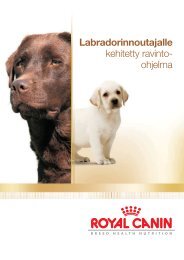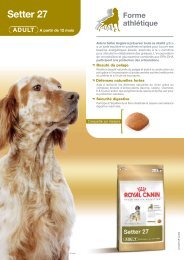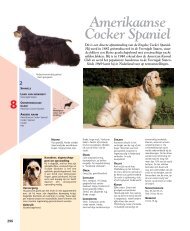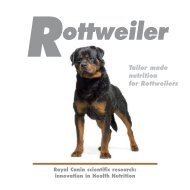You also want an ePaper? Increase the reach of your titles
YUMPU automatically turns print PDFs into web optimized ePapers that Google loves.
1 – Retina<br />
2 – Optic nerve<br />
3 – Cornea<br />
4 – Crystalline lens<br />
5 – Vitreous humour<br />
6 - Iris<br />
Anatomy of the eyeball<br />
The risks of cataracts in Cockers<br />
Recent studies show that Cocker Spaniels are among<br />
the breeds with a higher risk of cataracts (Adkins<br />
and Hendrix, 2005; Gelatt and Mackay, 2005).<br />
That risk is 2x for American Cockers and 1.9x for<br />
English Cockers (Purdue Veterinary Medical Data<br />
Base). There is a hereditary form that affects the<br />
American Cocker and hereditary transmission is suspected<br />
with respect to some types of cataract in the<br />
English Cocker (The Kennel Club, 2006). English<br />
Cockers suffering from cataracts have lower vitamin<br />
C plasma levels than healthy dogs (Barros et al,<br />
1999). This may be an indication that low-level synthesis<br />
of vitamin C lowers its concentration in the<br />
aqueous humour, the liquid that nourishes the eye.<br />
Retinal disease in Cockers<br />
Progressive retinal atrophy<br />
Light rays enter the eye through the pupil, passing through<br />
the crystalline lens before converging on the retina. The light<br />
Progressive retinal atrophy (PRA) is a hereditary<br />
information is then transmitted by the optic nerve to the brain<br />
disease that can gradually evolve towards total blind-<br />
where it is analysed. If the crystalline lens is opaque the rays will ness. Compared with the average population, the<br />
not be able to reach the retina.<br />
risk of PRA is said to be 45 times greater in the<br />
English Cocker (Dorn et al, 2001). The most widespread<br />
form of PRA in the Cocker is however the<br />
degeneration of the rods, the retina’s photoreceptors, which are specialised in mesopic vision. The<br />
first clinical signs generally appear between three and eight years (Chaudieu, 1997). The dog seems<br />
to be disoriented at night or is hesitant about entering a dark room. There is a genetic screening test<br />
for English Cockers, while one is said to be in development for American Cockers. This disease is<br />
thought to be linked to a primary deficiency in vitamin E, which is liable to develop even when the<br />
level of vitamin E is in line with common nutritional recommendations (McLellan et al, 2002).<br />
14
















